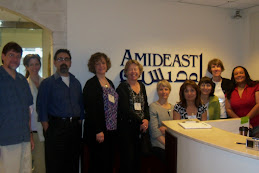 Qatar's representation of its history:
Qatar's representation of its history:Bedouin men in the desert enjoying tea and a talk. Note the obligatory falcon to the left. Note the absence of women in any of these paintings.

Qatar's self-image today--pro-business, pro-West, pro-money.
It's always interesting to me to observe how nations (or other communities) define themselves. It's particularly interesting in a place like Qatar. Although this area has been continuously inhabited for thousands of years, there is very little material evidence of this inhabitation--no old towns, very few artefacts and little to no written record. The Arabs who lived here were mainly Bedouins who lived in tents and moved frequently. They could not afford to be burdened with material possessions. Some people lived in towns and made their living by fishing and pearling, but apparently they lived in houses that did not last long. The culture was oral rather than literate, so there is no tradition of publishing (although there is a strong tradition of oral poetry.)
The other day we visited FANAR, a center designed to educate the public on Arab and especially Muslim identity. On the ceiling in one of the rooms were paintings depicting Qatari culture as they are defining it today. I have reproduced these paintings in this post.

Traditional buildings in town.

Qatar (like UAE) used to depend heavily on pearl diving for income. This industry came to end with the rise of the Japanese cultured pearls in the 1920s.



No comments:
Post a Comment